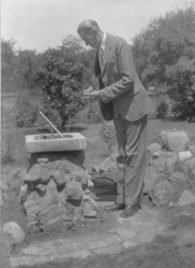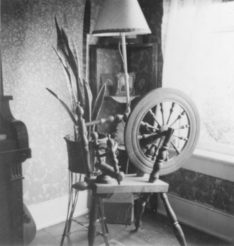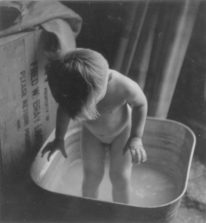
The House Where I Was Born (page 2)
Living, including sleeping, in our house was far from pleasant. I remember, from the
chilly autumn when the east winds and rain came, until the last snow disappeared in the
Spring, there was a constant struggle to maintain home comfort. Our old house was never
insulated against the cold. The damp, cold winds whistled their way through every little
chink and cranny as well as around every window and door. Apparently we could not afford a
storm window for each window. They did not seem to make much difference anyway. However,
we all got used to this, as part of our way of life, here in the country. However, there
was a great deal of work involved to keep this old house more or less comfortable. Our
fuel supply was the wood-lot away at the back of the place. It was necessary to keep a
plentiful supply in the wood-yard by the house. Every night we had to make sure that the
wood-box was filled along with some dry kindling to use for starting fires again in the
morning.
 Originally,
the house boasted four chimneys, because there were four stoves. The kitchen range, the
usual old-time cast iron range complete with warming oven and water reservoir attached,
provided heat for this area as well as the regular duties. In the livingroom, I recall
seeing a classical looking coal stove. It had little isinglass windows through which I
could see little blue and green flames. This information told us that the stove was alive
and well. Protecting the floor under the stoves was the usual wood and zinc mat. On the
mat beside the stove there was always a coal scuttle full of black hard coal. In due time,
this grand looking stove was replaced by a "Quebec Heater". This was a
wood-burning stove accommodating large chunks of fire-wood as fuel.
Originally,
the house boasted four chimneys, because there were four stoves. The kitchen range, the
usual old-time cast iron range complete with warming oven and water reservoir attached,
provided heat for this area as well as the regular duties. In the livingroom, I recall
seeing a classical looking coal stove. It had little isinglass windows through which I
could see little blue and green flames. This information told us that the stove was alive
and well. Protecting the floor under the stoves was the usual wood and zinc mat. On the
mat beside the stove there was always a coal scuttle full of black hard coal. In due time,
this grand looking stove was replaced by a "Quebec Heater". This was a
wood-burning stove accommodating large chunks of fire-wood as fuel.
The stove-pipe from the stove in this area went up through the floor, through the
master bedroom and thence into the chimney. This was the only heat source for Ma and Pa's
room. Then there were two other small stoves. They were called "Box Stoves". One
was set up in the parlour with its flue pipe passing through the bedroom above where Earl
and Bob slept. However, this stove was used only on special occasions when we were
entertaining special guests. The other similar stove heated the room occupied by Auntie
and Grandma. The heat from this stove would heat our bedroom where Louis and I slept.
These four chimneys had to be kept clean to avoid chimney fires, which were always a
threat. Cleaning chimneys was part of the Spring house-cleaning.
 Come
nightfall, our house was lighted by smelly kerosene (coal oil) lamps. There was a lamp of
some sort for each room of the house, along with a supply of matches in match holders.
There was a lamp shelf at the head of the stairs for the bedroom lamps. In the livingroom
there was a shelf for lamps as well as for the clock. There was the match safe with a
scratching pad of sandpaper beside it. Each of these lamps had to be kept supplied with
oil as well as have its glass chimney daily cleaned with a bit of old newspaper and
polished with the faithful duster made from an outworn nightshirt. This form of lighting
was only one step ahead of candle-light. In the course of time, an improvement occurred
when Pa acquired the dealership for The Alladin Mantel Lamp Company. This did help to
improve the lighting situation.
Come
nightfall, our house was lighted by smelly kerosene (coal oil) lamps. There was a lamp of
some sort for each room of the house, along with a supply of matches in match holders.
There was a lamp shelf at the head of the stairs for the bedroom lamps. In the livingroom
there was a shelf for lamps as well as for the clock. There was the match safe with a
scratching pad of sandpaper beside it. Each of these lamps had to be kept supplied with
oil as well as have its glass chimney daily cleaned with a bit of old newspaper and
polished with the faithful duster made from an outworn nightshirt. This form of lighting
was only one step ahead of candle-light. In the course of time, an improvement occurred
when Pa acquired the dealership for The Alladin Mantel Lamp Company. This did help to
improve the lighting situation.
Other things also began to improve. The outdoor toilet which was located some distance
from the back door, where it was a health hazard in winter, was at last found to be
intolerable. So this was relocated into a part of the woodshed just outside the kitchen
door. Now one could attend to natural functions without going out into the cold and wet. A
steel tank replaced the earthen pit.
 Washday was always quite an event at our house. The wash water was heated in a
large copper boiler on the kitchen range. Soft water either from a rain barrel or the
cistern, was used. Our laundry was out of doors on the back porch when the weather was
suitable. Otherwise, especially in the winter months, the washing machine was moved into
the woodshed. The tried and true washboard was common at our house for small jobs. For the
regular washings, we had a hand operated "washer". It was often my job to
operate this -- back and forth, back and forth, in a semi-rotary motion, until Ma judged
that they would now be clean. After washing and rinsing in bluing water, they were wrung
out with a hand-operated clothes wringer and hung on the clothes line to dry. Ma always
tried to choose a day that promised to be a good drying day. In the wintertime, the
washing was usually finished drying on folding clothes rack or stretched over backs of
chairs in the livingroom near the stove. In time, Pa was able to get a power-driven washer
and a small gasoline engine to operate it, all secondhand, of course. This made less work
and at the same time gave Pa something else to tinker with.
Washday was always quite an event at our house. The wash water was heated in a
large copper boiler on the kitchen range. Soft water either from a rain barrel or the
cistern, was used. Our laundry was out of doors on the back porch when the weather was
suitable. Otherwise, especially in the winter months, the washing machine was moved into
the woodshed. The tried and true washboard was common at our house for small jobs. For the
regular washings, we had a hand operated "washer". It was often my job to
operate this -- back and forth, back and forth, in a semi-rotary motion, until Ma judged
that they would now be clean. After washing and rinsing in bluing water, they were wrung
out with a hand-operated clothes wringer and hung on the clothes line to dry. Ma always
tried to choose a day that promised to be a good drying day. In the wintertime, the
washing was usually finished drying on folding clothes rack or stretched over backs of
chairs in the livingroom near the stove. In time, Pa was able to get a power-driven washer
and a small gasoline engine to operate it, all secondhand, of course. This made less work
and at the same time gave Pa something else to tinker with.
Eventually, hydroelectric power found its way into our community, and we were able to
save up for a used electric range, followed by a used electric refrigerator, and then an
electric-powered washing machine. Things were, indeed beginning, just beginning, to look
better for Ma and Pa and their family.
Next (page 3)
Dedication Acknowledgements Preface A Word About The
Author
Where It All Began My
Beginning The Days Of My Youth
Home-Made Bread And Farmer's Market
Patent No. 261912
Some Rural Characters And Events
The Party Line Telephone
My Ma And Pa The House Where I Was Born
The Symphony Of The Seasons Trial And Error Down
South -- A Family Vacation Outward And
Onward A Profile Of Me
Prophetic Vision From The Back Forty Epilogue
Copyright © by Ken Muma
For more...please visit Hayseed
Philosophy
 Originally,
the house boasted four chimneys, because there were four stoves. The kitchen range, the
usual old-time cast iron range complete with warming oven and water reservoir attached,
provided heat for this area as well as the regular duties. In the livingroom, I recall
seeing a classical looking coal stove. It had little isinglass windows through which I
could see little blue and green flames. This information told us that the stove was alive
and well. Protecting the floor under the stoves was the usual wood and zinc mat. On the
mat beside the stove there was always a coal scuttle full of black hard coal. In due time,
this grand looking stove was replaced by a "Quebec Heater". This was a
wood-burning stove accommodating large chunks of fire-wood as fuel.
Originally,
the house boasted four chimneys, because there were four stoves. The kitchen range, the
usual old-time cast iron range complete with warming oven and water reservoir attached,
provided heat for this area as well as the regular duties. In the livingroom, I recall
seeing a classical looking coal stove. It had little isinglass windows through which I
could see little blue and green flames. This information told us that the stove was alive
and well. Protecting the floor under the stoves was the usual wood and zinc mat. On the
mat beside the stove there was always a coal scuttle full of black hard coal. In due time,
this grand looking stove was replaced by a "Quebec Heater". This was a
wood-burning stove accommodating large chunks of fire-wood as fuel.
 Come
nightfall, our house was lighted by smelly kerosene (coal oil) lamps. There was a lamp of
some sort for each room of the house, along with a supply of matches in match holders.
There was a lamp shelf at the head of the stairs for the bedroom lamps. In the livingroom
there was a shelf for lamps as well as for the clock. There was the match safe with a
scratching pad of sandpaper beside it. Each of these lamps had to be kept supplied with
oil as well as have its glass chimney daily cleaned with a bit of old newspaper and
polished with the faithful duster made from an outworn nightshirt. This form of lighting
was only one step ahead of candle-light. In the course of time, an improvement occurred
when Pa acquired the dealership for The Alladin Mantel Lamp Company. This did help to
improve the lighting situation.
Come
nightfall, our house was lighted by smelly kerosene (coal oil) lamps. There was a lamp of
some sort for each room of the house, along with a supply of matches in match holders.
There was a lamp shelf at the head of the stairs for the bedroom lamps. In the livingroom
there was a shelf for lamps as well as for the clock. There was the match safe with a
scratching pad of sandpaper beside it. Each of these lamps had to be kept supplied with
oil as well as have its glass chimney daily cleaned with a bit of old newspaper and
polished with the faithful duster made from an outworn nightshirt. This form of lighting
was only one step ahead of candle-light. In the course of time, an improvement occurred
when Pa acquired the dealership for The Alladin Mantel Lamp Company. This did help to
improve the lighting situation. Washday was always quite an event at our house. The wash water was heated in a
large copper boiler on the kitchen range. Soft water either from a rain barrel or the
cistern, was used. Our laundry was out of doors on the back porch when the weather was
suitable. Otherwise, especially in the winter months, the washing machine was moved into
the woodshed. The tried and true washboard was common at our house for small jobs. For the
regular washings, we had a hand operated "washer". It was often my job to
operate this -- back and forth, back and forth, in a semi-rotary motion, until Ma judged
that they would now be clean. After washing and rinsing in bluing water, they were wrung
out with a hand-operated clothes wringer and hung on the clothes line to dry. Ma always
tried to choose a day that promised to be a good drying day. In the wintertime, the
washing was usually finished drying on folding clothes rack or stretched over backs of
chairs in the livingroom near the stove. In time, Pa was able to get a power-driven washer
and a small gasoline engine to operate it, all secondhand, of course. This made less work
and at the same time gave Pa something else to tinker with.
Washday was always quite an event at our house. The wash water was heated in a
large copper boiler on the kitchen range. Soft water either from a rain barrel or the
cistern, was used. Our laundry was out of doors on the back porch when the weather was
suitable. Otherwise, especially in the winter months, the washing machine was moved into
the woodshed. The tried and true washboard was common at our house for small jobs. For the
regular washings, we had a hand operated "washer". It was often my job to
operate this -- back and forth, back and forth, in a semi-rotary motion, until Ma judged
that they would now be clean. After washing and rinsing in bluing water, they were wrung
out with a hand-operated clothes wringer and hung on the clothes line to dry. Ma always
tried to choose a day that promised to be a good drying day. In the wintertime, the
washing was usually finished drying on folding clothes rack or stretched over backs of
chairs in the livingroom near the stove. In time, Pa was able to get a power-driven washer
and a small gasoline engine to operate it, all secondhand, of course. This made less work
and at the same time gave Pa something else to tinker with.